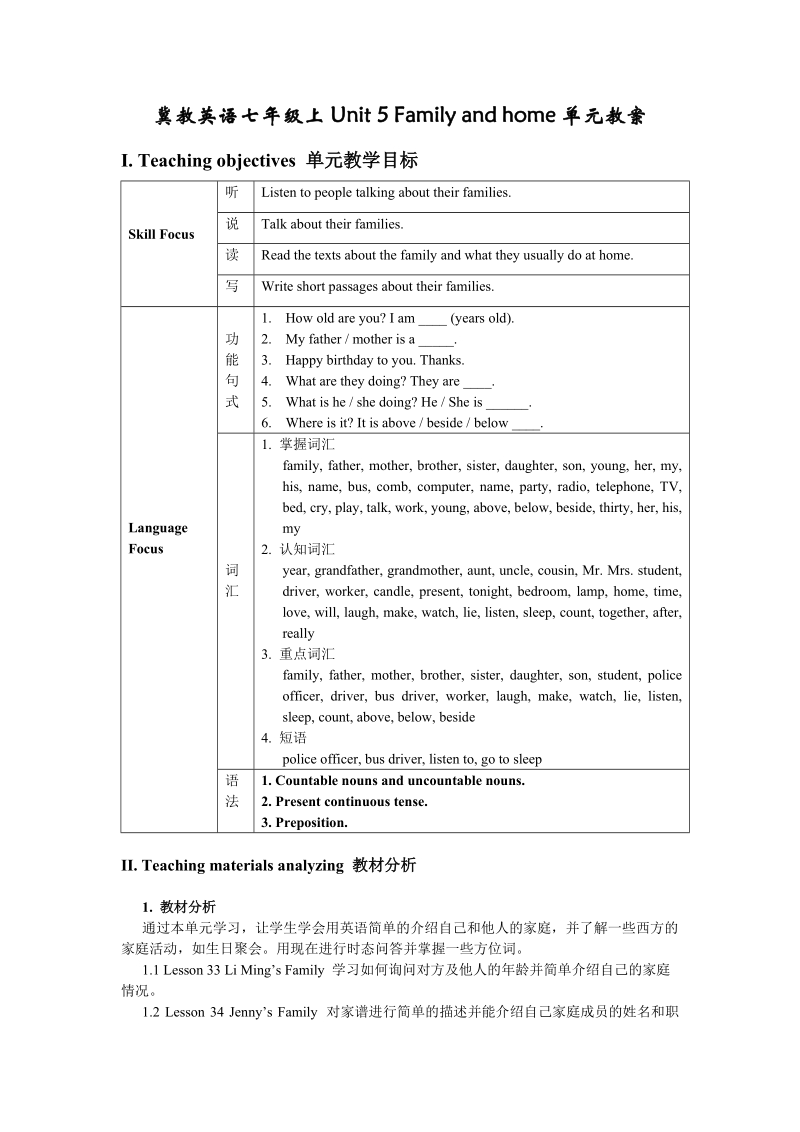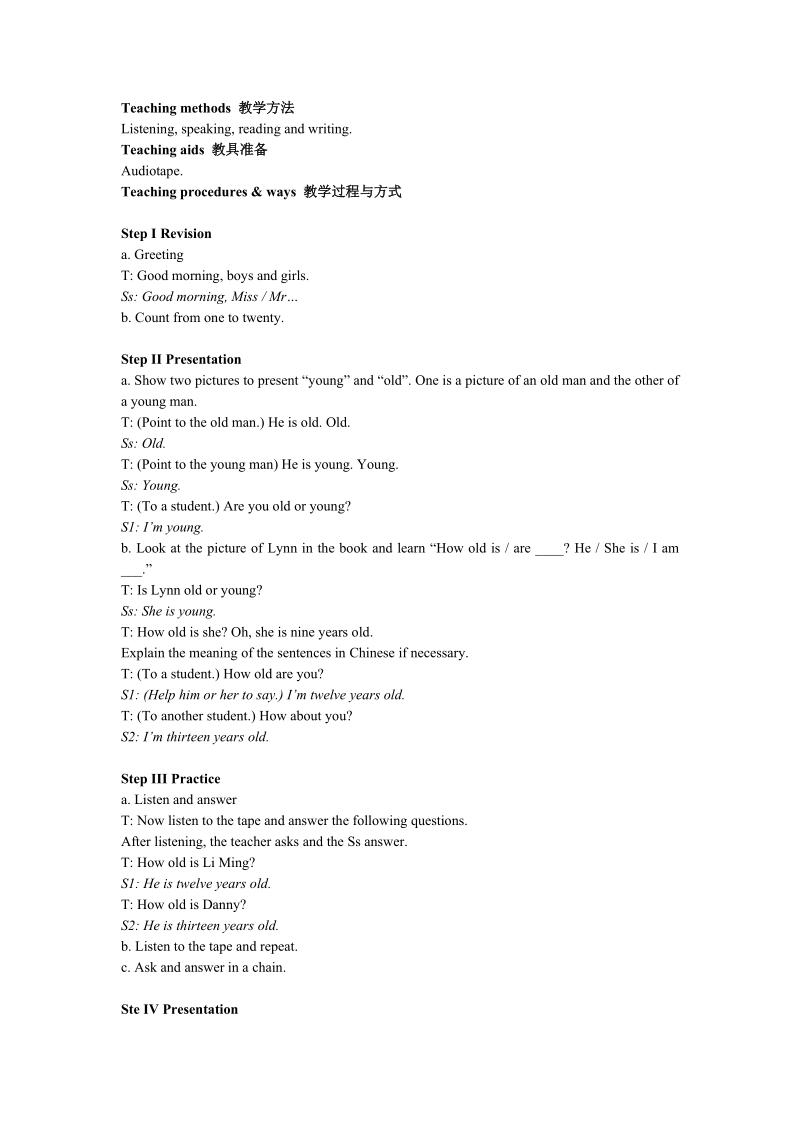 冀教版英语七年级上Unit5教案
冀教版英语七年级上Unit5教案
《冀教版英语七年级上Unit5教案》由会员分享,可在线阅读,更多相关《冀教版英语七年级上Unit5教案(17页珍藏版)》请在七七文库上搜索。
1、冀教英语七年级上 Unit 5 Family and home 单元教案I. Teaching objectives 单元教学目标听 Listen to people talking about their families.说 Talk about their families.读 Read the texts about the family and what they usually do at home.Skill Focus写 Write short passages about their families.功能句式1. How old are you? I am _ (years
2、 old). 2. My father / mother is a _. 3. Happy birthday to you. Thanks. 4. What are they doing? They are _.5. What is he / she doing? He / She is _.6. Where is it? It is above / beside / below _. 词汇1. 掌握词汇family, father, mother, brother, sister, daughter, son, young, her, my, his, name, bus, comb, co
3、mputer, name, party, radio, telephone, TV, bed, cry, play, talk, work, young, above, below, beside, thirty, her, his, my2. 认知词汇 year, grandfather, grandmother, aunt, uncle, cousin, Mr. Mrs. student, driver, worker, candle, present, tonight, bedroom, lamp, home, time, love, will, laugh, make, watch,
4、lie, listen, sleep, count, together, after, really3. 重点词汇family, father, mother, brother, sister, daughter, son, student, police officer, driver, bus driver, worker, laugh, make, watch, lie, listen, sleep, count, above, below, beside4. 短语police officer, bus driver, listen to, go to sleepLanguage Foc
5、us语法1. Countable nouns and uncountable nouns.2. Present continuous tense. 3. Preposition.II. Teaching materials analyzing 教材分析1. 教材分析通过本单元学习,让学生学会用英语简单的介绍自己和他人的家庭,并了解一些西方的家庭活动,如生日聚会。用现在进行时态问答并掌握一些方位词。1.1 Lesson 33 Li Mings Family 学习如何询问对方及他人的年龄并简单介绍自己的家庭情况。1.2 Lesson 34 Jennys Family 对家谱进行简单的描述并能介绍自
6、己家庭成员的姓名和职业。 1.3 Lesson 35 Happy Birthday! 了解一些生日聚会的有关内容及背景知识。1.4 Lesson 37 In the Bed Room 通过学习掌握一些家具和电器的名称,并能简单描述物体的位置。1.5 Lesson 38 Jenny Is at Home 通过学习学会描述在家的一些日常活动并复习一般现在时。1.6 Lesson 39 Lets Count! 学习数字 20 至 30,并在歌曲当中学习有关日常活动的表达方式。1.7 Lesson 36 Families Play and Work 学习现在进行时态,并了解家庭的一些常见活动。1.8
7、Lesson 40 Unit Review 通过练习及对话来复习整个单元的主要单词和表达法。2. 课型设计与课时分配Period 1 Lesson 33 Listening, speaking and readingPeriod 2 Lesson 34 Listening, speaking and readingPeriod 3 Lesson 35 Listening, singing and speakingPeriod 4 Lesson 37 & Lesson 38 (Part One) Listening and speakingPeriod 5 Lesson 38 (Part Two
8、) Listening, speaking and readingPeriod 6 Lesson 39 Listening, reading and singingPeriod 7 Lesson 36 Listening, speaking, reading and singingPeriod 8 Lesson 40 Task-based speakingIII. Teaching plans for each period 分课时教案Period 1 Listening, speaking and readingTarget language 目标语言 1. Words and phrase
9、s 生词和短语family, father, mother, brother, sister, daughter, son, young, year, grandfather, grandmother, aunt, uncle, cousin, love2. Key sentences 重点句子How old are you? I am _ (years old). How old is she / he? She / He is _ (years old).Ability goals 能力目标Enable students to ask and answer about the age an
10、d introduce their families.Learning ability goals 学能目标Help students grasp the expressions to introduce their family members: name, age and the relationship with them. Teaching important points 教学重点How to ask about peoples age.Teaching difficult points 教学难点Learn the expressions to introduce their fam
11、ily members.Teaching methods 教学方法Listening, speaking, reading and writing.Teaching aids 教具准备Audiotape.Teaching procedures & ways 教学过程与方式Step I Revisiona. GreetingT: Good morning, boys and girls.Ss: Good morning, Miss / Mrb. Count from one to twenty.Step II Presentationa. Show two pictures to present
12、 “young” and “old”. One is a picture of an old man and the other of a young man.T: (Point to the old man.) He is old. Old.Ss: Old.T: (Point to the young man) He is young. Young.Ss: Young.T: (To a student.) Are you old or young?S1: Im young.b. Look at the picture of Lynn in the book and learn “How ol
13、d is / are _? He / She is / I am _.”T: Is Lynn old or young?Ss: She is young.T: How old is she? Oh, she is nine years old. Explain the meaning of the sentences in Chinese if necessary.T: (To a student.) How old are you?S1: (Help him or her to say.) Im twelve years old.T: (To another student.) How ab
14、out you?S2: Im thirteen years old.Step III Practicea. Listen and answerT: Now listen to the tape and answer the following questions.After listening, the teacher asks and the Ss answer.T: How old is Li Ming?S1: He is twelve years old.T: How old is Danny?S2: He is thirteen years old.b. Listen to the t
15、ape and repeat.c. Ask and answer in a chain.Ste IV PresentationLook at the pictures in the student book of Li Mings family and read the words several times.Step V Practicea. Listen to the tape and repeat.The teacher writes some words on the blackboard, then Ss retell according to these words.b. Lear
16、n1. In English “grandfather”, “grandmother”, “aunt”, “uncle”, “cousin”, “brother”, and “sister” have more than one meaning.2. I have no or e.g. I have no brothers or sisters.I have no car or house.c. Draw their own family trees and talk about “My Family.”T: This is Ling Mings family tree. There are
17、ten members. Ill give you three minutes to draw your family trees. Then show your picture and tell us the members of your family.Then ask several students to present in front of class.T: Good job. Next class you could take a photo of your family if you like. Then you can introduce your family member
18、 to us. OK?Ss: OK.Step VI Homeworka. Finish the exercise in the activity book.b. Recite the passage in this lesson and write a short one about your family.c. Preview Lesson 34.Period 2 Listening, speaking and readingTarget language 目标语言 1. Words and phrases 生词和短语her, my, his, name, bus, Mr., Mrs., s
19、tudent, police officer, driver, bus driver, worker2. Key sentences 重点句子My _ is a _. Her / His name is _.She lives in Canada. We are the Smith familyAbility goals 能力目标Enable students to introduce others families according to the family trees and their own family members jobs and names.Learning abilit
20、y goals 学能目标Help students grasp the expressions to introduce others families and their own family members jobs and names. Teaching important points 教学重点How to introduce their family members.Teaching difficult points 教学难点Learn to introduce the family members jobs and names.Teaching methods 教学方法Listen
21、ing, speaking and reading.Teaching aids 教具准备Audiotape and pictures.Teaching procedures & ways 教学过程与方式Step I Revisiona. GreetingT: Good morning, boys and girls.Ss: Good morning, Miss / Mrb. Ask and answer about each others ages.c. Introduce the family according to the family tree or the photo.T: Is t
22、here anyone who take the photo of your family? If you take the photo, show it and introduce them to us.Step II PresentationIntroduce Li Mings family, present the verb form for the third person singular form and explain the use of them.T: This is Li Mings family. He lives in Canada. He has no brother
23、s or sisters. His mother and father only have one son, Li Ming. His uncle and aunt have one daughter, Jing. He loves his family.Step III Practicea. Listen to the tape and answer the following questions:1. Where does Jenny live? (She lives in Canada.)2. Who is Mr. Smith? (He is Jennys father.)3. What
24、 is her brothers name? (Her brothers name is Bob.)4. Who is Lynn? (She is Jennys sister.)b. Listen to the tape and repeat.c. Draw and talkLet the students draw their family trees and exchange them with their partners. Then talk about their partners family trees.Step IV PresentationShow pictures to i



- 配套讲稿:
如PPT文件的首页显示word图标,表示该PPT已包含配套word讲稿。双击word图标可打开word文档。
- 特殊限制:
部分文档作品中含有的国旗、国徽等图片,仅作为作品整体效果示例展示,禁止商用。设计者仅对作品中独创性部分享有著作权。
- 关 键 词:
- 冀教版 英语 年级 Unit5 教案
 七七文库所有资源均是用户自行上传分享,仅供网友学习交流,未经上传用户书面授权,请勿作他用。
七七文库所有资源均是用户自行上传分享,仅供网友学习交流,未经上传用户书面授权,请勿作他用。



 浙公网安备33030202001339号
浙公网安备33030202001339号
链接地址:https://www.77wenku.com/p-35028.html